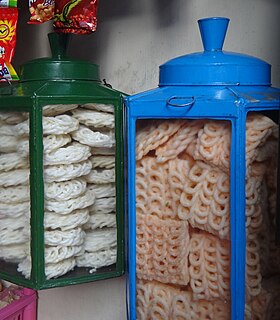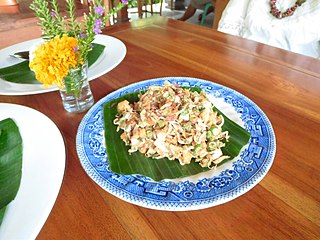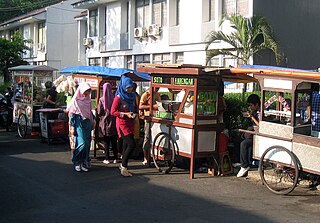
Indonesian cuisine is a collection of various regional culinary traditions that formed the archipelagic nation of Indonesia. There are a wide variety of recipes and cuisines in part because Indonesia is composed of approximately 6,000 populated islands of the total 17,508 in the world's largest archipelago, with more than 1,300 ethnic groups. Many regional cuisines exist, often based upon indigenous culture with some foreign influences. Indonesia has around 5,350 traditional recipes, with 30 of them considered the most important. Indonesia's cuisine may include rice, noodle and soup dishes in modest local eateries to street-side snacks and top-dollar plates.

Rijsttafel, a Dutch word that literally translates to "rice table", is an Indonesian elaborate meal adapted by the Dutch following the hidang presentation of nasi padang from the Padang region of West Sumatra. It consists of many side dishes served in small portions, accompanied by rice prepared in several different ways. Popular side dishes include egg rolls, sambals, satay, fish, fruit, vegetables, pickles, and nuts. In most areas where it is served, such as the Netherlands, and other areas of strong Dutch influence, it is known under its Dutch name.

Glodok is an urban village of Taman Sari, West Jakarta, Indonesia. The area is also known as Pecinan or Chinatown since the Dutch colonial era, and is considered the biggest in Indonesia. Majority of the traders and residents of Glodok are Chinese descent. The area dates back to colonial times when in November 1740, Dutch East Indies Company designated Glodok as a residential area for ethnic Chinese. Administratively, the area is a kelurahan under the Taman Sari district, West Jakarta.

Peanut sauce, satay sauce, bumbu kacang, sambal kacang, or pecel is an Indonesian sauce made from ground roasted or fried peanuts, widely used in cuisines worldwide.

Emping are a type of Indonesian chips, a bite-size snack kripik cracker, made of melinjo or belinjo nuts. Emping crackers have a slightly bitter taste. Emping snacks are available in markets plain (original), salty, spicy or sweet, depending on the addition of salt or caramelized sugar.

Lontong is an Indonesian dish made of compressed rice cake in the form of a cylinder wrapped inside a banana leaf, commonly found in Indonesia, Malaysia and Singapore. Rice is rolled inside a banana leaf and boiled, then cut into small cakes as a staple food replacement of steamed rice. The texture is similar to those of ketupat, with the difference being that the ketupat container is made from woven janur fronds, while lontong uses banana leaf instead.

Javanese cuisine is the cuisine of Javanese people, a major ethnic group in Indonesia, more precisely the province of Central Java, Yogyakarta and East Java.

Plecing kangkung is an Indonesian spicy water spinach dish from the island of Lombok. Plecing kangkung is made from blanched water spinach leaves and served cold with plecing sambal made from ground red chili pepper, shallot, garlic, bird's eye chili, candlenut, kaffir lime, shrimp paste, salt, and sugar. As a side for the Lomboknese dish Ayam taliwang, plecing kangkung is also usually served with additional ingredients such as bean sprouts, string beans, fried peanuts, and urap's grated spicy coconut dressing. Outside Lombok, plecing kangkung is also commonly served in the neighboring island Bali.

Betawi cuisine is rich, diverse and eclectic, in part because the Betawi people that create them were composed from numbers of regional immigrants that came from various places in the Indonesian archipelago, as well as Chinese, Indian, Arab, and European traders, visitors and immigrants that were attracted to the port city of Batavia since centuries ago.

Kupat, ketupat, or tipat is a Javanese rice cake packed inside a diamond-shaped container of woven palm leaf pouch, Originating in Indonesia, it is also found in Brunei, Malaysia, Singapore and southern Thailand. It is commonly described as "packed rice", although there are other types of similar packed rice such as lontong and bakchang.

Ayam bakar is an Indonesian and Malaysian dish, consisting of charcoal-grilled chicken. Ayam bakar literally means "roasted chicken" in Indonesian and Malay.

Soto is a traditional Indonesian soup mainly composed of broth, meat, and vegetables. Many traditional soups are called soto, whereas foreign and Western influenced soups are called sop.

Krupuk (Javanese), kerupuk (Indonesian), keropok (Malay), kroepoek (Dutch) or kropek (Tagalog) is a cracker made from starch or animal skin and other ingredients that serve as flavouring. Most krupuk are deep fried, while some others are grilled or hot sand fried. They are a popular snack in maritime Southeast Asia, and is most closely associated with the culinary traditions of Indonesia, in particular Javanese cuisine. It is an ubiquitous staple in its country of origin, and has spread to other countries either via the migration of diaspora populations or exports.

Rujak or Rojak is a salad dish of Javanese origin, commonly found in Indonesia, Malaysia and Singapore. The most popular variant in all three countries is a salad composed of a mixture of sliced fruit and vegetables served with a spicy palm sugar dressing. It is often described as tangy and spicy fruit salad due to its sweet, hot and spicy dressing made from ground chilli, palm sugar and peanuts.

Karedok is a raw vegetable salad in peanut sauce from Sundanese region, West Java, Indonesia. It is one of the Sundanese signature dish. It traditionally includes longbeans, cucumbers, bean sprouts, cabbage, legumes, Thai basil, and small green eggplant, covered in peanut sauce dressing, but there are now many variations. It is very similar to gado-gado, except all the vegetables are raw, while most of gado-gado vegetables are boiled, and it uses kencur, Thai basil and eggplant. Karedok is also known as lotek atah for its fresh and raw version of the vegetable covered with peanut sauce. Karedok is widely served as daily food in the Sundanese family, usually eaten with hot rice, tofu, tempeh, and krupuk. Nowadays karedok can be found in many variation from hawkers carts, stalls (warung) as well as in restaurants and hotels both in Indonesia and worldwide.

Gado-gado is an Indonesian salad of raw, slightly boiled, blanched or steamed vegetables and hard-boiled eggs, boiled potato, fried tofu and tempeh, and lontong, served with a peanut sauce dressing.

Indonesian street food is a collection of ready-to-eat meals, snacks, fruits and drinks sold by hawkers or vendors at warung food stalls or food carts. Street food in Indonesia is a diverse mix of local Indonesian, Chinese, and Dutch influences. Indonesian street food are usually cheap, offer a great variety of food of different tastes, and can be found on every corner of the city.

Ayam bumbu rujak is a typical Indonesian Javanese food made from chicken meat which is still young and uses a red basic spice then grilled. A red base is a spice made from salt, garlic, onion, and red chili. Called seasoning rujak because there are many spices besides chili, including brown sugar which is commonly used in fruit rojak sauce. Ayam bumbu rujak often called ayam bakar bumbu rujak since it is grilled, thus often regarded as one variant of various ayam bakar recipes.

Bawang goreng is an Indonesian crispy fried shallots condiment, a popular garnish to be sprinkled upon various dishes of Indonesian cuisine. It is quite similar to crisp fried onion.


















